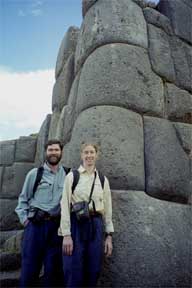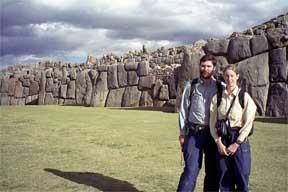Wow in two days we are constantly blown away! We have walked all over
the old part of the city. Vendors every where. Very beautiful Colonial
buildings. But they pail to the Inca walls that are left. Most of the
buildings in the old town are built on top of the old Inca walls. The
old City is in the shape of a Puma lying down. The Ruins of Saqsaywahman
(sounds like sexywoman) or what is left of them I cannot understand how
they were built. The largest stones are over 130 TONS! They are aboslutly
perfictly fitted together. Infact they have tried to duplicate this work
with todays tools and it is not as good! We have also seem many other
ruins in the area. The Incan Impire was HUGE! Too bad others greed brought
them to their demise!
-Gary
Morning on our own exploring the living museum of Cusco. All the ruins
in town have Spanish homes built on top. The brick work in beautiful.
We visited the Church that was built on Inca Ruins, it collapsed in the
1950 earthquake revealing the Inca ruins. They rebuilt the church, but
left the ruins for a museum. Also visited Sacsayhuaman, Tambo Machay,
Quango, Puca Pucara all within the area of Cusco. Dinner was at a restaurant
in the Plaza de Armas.
-Bindy
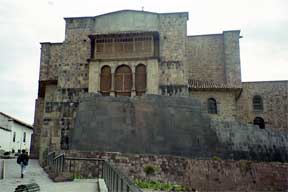
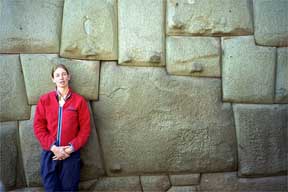
Inca Wall in Cusco
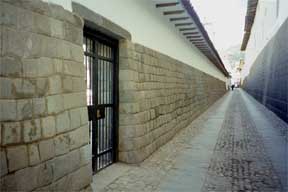
Cuzco was alternately the navel of the world, the umbilical life-giver, and the puma, the stealthy predator. The Incan Empire, much like the Roman, consolidated its domain through a network of roads. This immense, 3000 mile network emanated from Cuzco. The city was laid out in a grid, the outline of which was thought to resemble a puma. The head of the puma was the important temple site Sacsayhuamán, a short one hour hike from Cuzco. This site was a fortress with enormous stone walls on a plateau at the edge of Cuzco. Only 20% of the original structure remains, most of it having been carted off to build Spanish Cuzco. That which remains is mostly the stones that the Spanish couldn't haul away -- the huge boulders expertly fitted together. Gazing at these walls, you get a sense of the resolute strength that speaks to the walls function as the bastion of defense for the mighty empire's capital.
